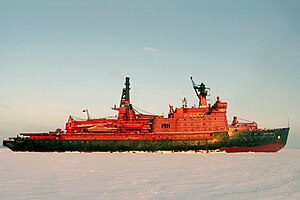Arktika (1972 nuclear icebreaker)

Russian nuclear icebreaker Arktika
|
|
| History | |
|---|---|
| Operator: | Atomflot |
| Port of registry: | Murmansk |
| Builder: | Baltic Shipyard, Leningrad |
| Launched: | 26 December 1972 |
| Completed: | 25 April 1975 |
| Out of service: | 2008 |
| General characteristics | |
| Class and type: | Arktika-class icebreaker |
| Tonnage: | 18,172 GRT |
| Displacement: | 23,460 tonnes |
| Length: | 147.9 m (485 ft) |
| Beam: | 29.9 m (98 ft) |
| Draught: | 11 m (36 ft) |
| Propulsion: | Nuclear-turbo-electric; three shafts 75,000 hp (56,000 kW) (combined) |
| Speed: | 20.8 knots (38.5 km/h; 23.9 mph) |
| Crew: | 150 |
NS Arktika (Russian: «Арктика»; IPA: [ˈarktʲɪkə]) is a retired nuclear-powered icebreaker of the Soviet (now Russian) Arktika class. In service from 1975 to 2008, she was the first surface ship to reach the North Pole, a feat achieved on August 17, 1977. Arktika required refuelling every three and a half years.
Construction of the ship began in the Baltic Shipyard in Leningrad on July 3, 1971. Sea trials completed successfully on December 17, 1975. For further information on the ship's design, construction and propulsion system, see Arktika class icebreaker.
In 1982, she was rechristened Leonid Brezhnev in honour of Leonid Brezhnev, the General Secretary of the Central Committee of the Communist Party of the Soviet Union from 1964 until his death in 1982. In 1986 the name reverted to Arktika, according to some accounts because the ship's crew disliked the new name and refused to respond to radio messages unless the ship was referred to as Arktika. Within a week of the strike, the name was changed back. Another explanation is that the original name change had been due to an administrative mixup, and the name Leonid Brezhnev had never been supposed to apply to Arktika at all, but had been intended for a different ship.
Arktika was retired for several years, but was repaired in the late 1990s.
Originally designed for 100,000 hours of reactor life, Arktika's service life was prolonged another 50,000 hours in 2000, and another 25,000 hours after that, adding eight years to a 25-year planned service life. The life extension was accomplished by means of replacing critical equipment to allow the safe and continued operation of the nuclear plant. On May 17, 2000, a conference of Russian engineers, scientists, and government officials took place on board Arktika after her first service extension. The extension cost only $4 million, compared to the $30–50 million cost of a new nuclear icebreaker, and proved to be a successful endeavor. The conference concluded thus that the lifetimes of Russian nuclear icebreakers could be successfully extended to 175,000 hours, and possibly more.
...
Wikipedia
